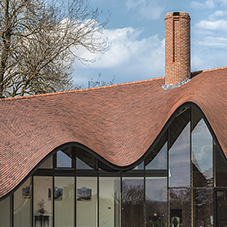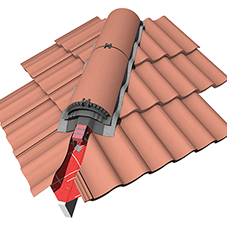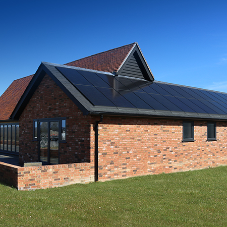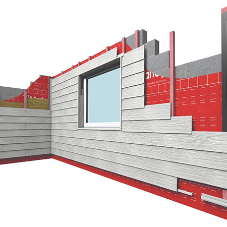From new Part L carbon reduction targets to fire safety and the Social Housing White Paper, Stuart Nicholson, roof systems director at Marley, discusses what factors will affect roof specification in 2021.
Pitched roofing is an increasingly important focus for specifiers. Not only does it contribute to the structural needs of the building, but it also helps to meet the comfort needs of Homeowners and tenants and is one of the biggest causes of call-backs for repairs.
With ongoing reforms to the building safety regulatory system and increasing focus on accountability in the construction sector, inevitably there will be more scrutiny on roofing specifications over the coming years. As the whole housing sector works towards the Future Homes Standard in 2025, the role of roofs as a platform for sustainable technologies also needs to be a priority.
So, what are the main factors to consider when specifying pitched roofs in 2021?
1 – Sustainability – Part L / Future Homes Standard
As a stepping stone towards the Future Homes Standard in 2025, new homes will be expected to produce 31% lower carbon emissions from 2021, as part of changes to Part L regulations.
Solar PV on roofs, combined with an efficient gas boiler, appears to be one of the most cost-effective ways of achieving this interim Part L carbon reduction target. Together with the inclusion of solar PV as an eligible measure in the Green Homes Grant scheme for local authorities, this means we are likely to see a big increase in the number of social housing developments installing solar PV roof systems over the next few years.
It is now much easier to install solar PV on roofing projects thanks to innovative new integrated systems, such as Marley’s SolarTile®, which are much easier to fit, don’t require a specialist contractor and blend seamlessly with the roof design.
2 – Building Safety Bill and Social Housing White Paper
Making sure social housing properties are safe, high quality and well maintained is of critical importance. Several initiatives, including the Government’s Social Housing White Paper and the Building Safety Bill, are set to place increased scrutiny on the safety and quality of social housing construction and maintenance.
Poorly performing roof systems can lead to ongoing and costly problems such as leaks, condensation and tiles falling off. Many of the problems we see with roofs are caused because there has been a change in the specification between the design and construction phase, or because inferior or incompatible products have been used further down the supply chain.
To ensure safety and quality, social housing specifiers need to consider the whole pitched roof system and the way it works together. Specifying the roof covering but leaving the choice of battens or dry fix system to contractor choice, allows too much risk of value engineering, incompatible materials, and non-compliance with British Standards.
3 – Preventing fires in roof voids
Recent reports from both the BRE and BBC Watchdog raised concerns that some modern homes could have inadequate, incorrectly installed or, in some cases, no fire barriers. In terraced or semi-detached properties, this increases the risk that fire could spread rapidly through roof voids from one home to the next. Specifiers should urgently review fire barrier specification, as feedback from contractors suggests that some products are difficult to install correctly.
Marley have just launched a brand new, easy-to-install fire barrier to help social housing providers reduce the risk of roof void fires. Marley Roof Defence has a double intumescent seal, with an inverted T design, so it can simply be installed under tiles and between roof battens to close all gaps in case of fire.
4 – Time saving and quality
The impact of COVID-19 has inevitably delayed building programmes and has also highlighted the national need to build more high quality, affordable homes. Therefore, a priority this year is to increase construction pace, without compromising on safety or quality.
It is possible to speed up the time of roofing projects with high coverage, quality roofing materials, that can replicate traditional looks in less time. Marley’s range includes easy-to-fix Edgemere slate-effect tiles and Lincoln and Eden interlocking pantiles, as well as time saving accessories, such as the SoloFix one-piece clip and nail and Universal Eaves Clip.
With so many factors affecting pitched roofing in 2021, one of the best ways to reduce risk and guarantee quality, is to shift towards full system specification, rather than just specifying individual components.
Specifying a full tested roof system, from one manufacturer, helps to minimise product substitution, or use of inferior materials further down the line, and gives a clear line of accountability. Marley’s roof system is one of the most comprehensive on the market, guaranteeing quality, compatibility, and compliance with British Standards, with a 15-year warranty for extra peace of mind. It is now also available with solar PV and Marley’s new Roof Defence fire barrier as options.
For further information, visit here.
Marley|Roof Specification in 2021 [Blog]
| T | (01283) 722588 |
|---|---|
| E | info@marley.co.uk |
| W | Visit Marley's website |
| Lichfield Rd, Branston, Burton-on-Trent, Staffs, DE14 3HD |
Products by this Company
Categories
Pitched roofs Roof tile fixings Roof tiles Solar PV panels

![Marley|Roof Specification in 2021 [Blog]](/Solar%20image%202-file114920.jpg)
![Marley|Roof Specification in 2021 [Blog]](/Solar%20installed%20close%20up-file114921.jpg)
![Marley|Roof Specification in 2021 [Blog]](/Roof%20Defence%20image%20-%20close%20up%20PNG-file114925.png)




